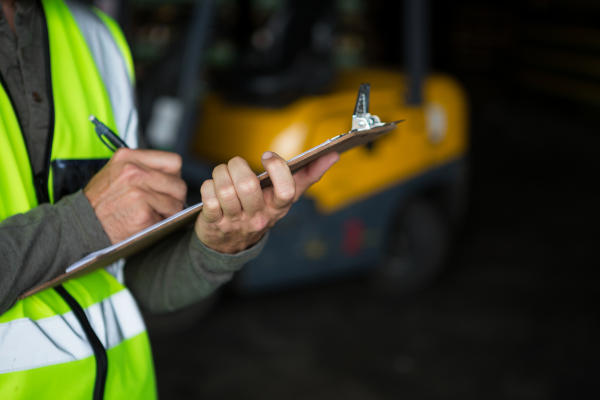What is a Safety Statement?
A safety statement is a legal requirement for all employers. It is a written document that describes how Health and Safety is managed within your organisation. This statement represents your duty of care to your employees, contractors, visitors, or any other individuals who may be affected by the activities in your workplace.
The safety statement explains how risks are identified and how those risks are controlled. This is done through the process of risk assessment, which informs the specific content of your company’s health and safety documentation.
All employers - including those who are self-employed - must have a WRITTEN SAFETY STATEMENT that is up to date and specific to their business.

All employers - including those who are self-employed - must have a WRITTEN SAFETY STATEMENT that is up to date and specific to their business.
Legal Requirement for Employers
The Safety, Health and Welfare at Work Act 2005, Section 20 states that a written and site-specific safety statement must be implemented by all employers. This includes:
- Companies with full-time employees
- Small businesses with part-time or contract staff
- Sole traders who engage others to work
- Any organisation that carries out work involving potential risks
If you are a Company Director or Senior Manager, you may be held personally liable for any breaches of health and safety legislation committed by your organisation. Maintaining a correct and complete safety statement is a crucial step in demonstrating legal compliance.
DO YOU NEED A SAFETY STATEMENT?
Fill in the form and we will contact you back. Fields marked * are required.
Key Features of a Safety Statement
A proper safety statement is not a generic template or one-size-fits-all document. It must be developed based on the specific risks and activities within your own workplace. Each business is different and the hazards present will vary depending on the nature of the work carried out.
At SafeHands, each safety statement is:
- Based on a full Risk Assessment of your premises
- Site-specific for your organisation or business
- Tailored to your work practices and procedures
The safety statement we provide reflects the actual conditions and operations in your business, ensuring full relevance and legal validity.

What the Safety Statement Includes
The full process of developing a safety statement includes several essential steps:
- Visit to Your Site
Our team will carry out a site visit in order to complete a Specific Risk Assessment. This assessment is essential in identifying risks and hazards that are present in your particular work environment. - Provision of a Health & Safety Manual
You will receive a manual that includes:- A complete site-specific hazard analysis
- A Risk Assessment Survey covering the work practices and environment
- Control suggestions to assist in reducing or eliminating identified risks
- Meeting with Management
Once your safety statement and supporting assessments have been prepared, we will arrange a meeting with management for the formal handover and explanation of the documentation.
These steps ensure that your business receives a complete, specific, and legally compliant safety statement tailored to your operational needs.
Why Site-Specific Documentation Is Critical
It is essential that every safety statement is created specifically for the site, activities, and procedures in place at your business. This ensures that the content is not only relevant but also legally valid in the event of an inspection or incident. The following considerations must be accounted for:
- Number of Employees
The scale of your workforce may affect the type and degree of risks that exist in your operations. - Nature of Business Activity
What your company actually does is central to the development of the safety statement. For example: - Is your company involved in the manufacturing of goods?
- Does your company use hazardous chemicals as part of its process?
- Use of Machinery or Equipment
If your staff operate equipment that poses medium or high risk, this must be factored into the risk assessment and control measures. - Current Control Measures
If risks exist, it is necessary to demonstrate how they are controlled. The safety statement should outline exactly how safety is maintained and risks are minimised during daily operations.
Risk Assessment
The foundation of every safety statement is the Risk Assessment. This is a structured examination of your workplace and work practices, designed to identify any potential risks or hazards to health and safety.
To complete this step, the following may be included (depending on your organisation's needs):
- Full site survey
- Assessment of current safety practices and procedures
- Review of risks specific to your trade or industry
- Evaluation of other identifiable risks, which may include:
- Noise
- Food Safety
- Fire Safety
- Exposure to hazardous chemicals or substances
Every aspect of the risk assessment process is documented and forms the evidence base for your final safety statement.
Control Measures
Once specific risks and hazards are identified, suitable control measures are recommended. These are strategies, equipment, or procedures that aim to reduce the level of risk or remove the hazard entirely.
For example:
- If a Noise Risk Assessment identifies high noise levels in the workplace, a control measure may involve the supply of Personal Protective Equipment (PPE), such as ear defenders. Employers may also be advised to encourage the use of such equipment actively.
- In some cases, training for employees may be suggested to raise awareness and help staff understand the risks they face, and how to reduce or avoid them.
All control measures are detailed in the safety statement, so that your business has a clear, documented plan for managing each risk.
Do You Need a Safety Statement?
If you operate a business in Ireland, the answer is almost certainly yes. If your organisation does not currently have a safety statement, or if your existing document is outdated or generic, you may not be compliant with current legislation.
At SafeHands, we provide compliant safety statements that meet the exact requirements of Irish health and safety law. These statements are always:
- Site-specific
- Based on a completed risk assessment
- Aligned with the Safety, Health and Welfare at Work Act 2005
Having a tailored, up-to-date safety statement is not just about legal compliance; it’s a critical part of managing day-to-day operations responsibly. A generic or outdated document does not meet the requirements of the Safety, Health and Welfare at Work Act 2005, and it may expose your business to unnecessary risk. By ensuring your safety statement is based on a proper risk assessment and reflects your actual work practices, you demonstrate a commitment to maintaining a safe environment. It also helps promote a safety-first culture among staff, which can improve awareness, reduce incidents, and support overall business continuity.
Need Safety Documentation for Construction or Trades?
SafeHands also specialises in tailored construction safety statements and detailed method statements designed for builders, contractors, and trades professionals. Stay compliant with industry regulations and keep your site teams protected with clear, practical safety documentation. Explore our construction and trades safety services.
